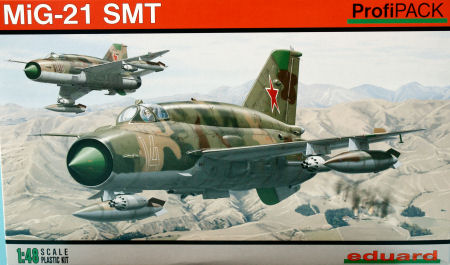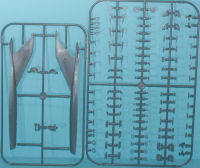
Eduard 1/48 MiG-21SMT Kit First Look
by Michael Benolkin
| Date of Review | July 2011 | Manufacturer | Eduard |
|---|---|---|---|
| Subject | MiG-21SMT | Scale | 1/48 |
| Kit Number | 8233 | Primary Media | Styrene, photo-etch |
| Pros | Still best kit of the MiG-21 in any scale | Cons | Decal stencils (see text) |
| Skill Level | Experienced | MSRP (USD) | $59.95 |
First Look
 |
 |
 |
 |
 |
 |
 |
 |
 |
The MiG-21 is one of the most successful supersonic fighters ever produced. The first production MiG-21 was a day fighter that was equipped with 2 NR-30 30mm guns and a range-only radar that would provide optimum firing range data for the pilot, similar to the F-100 Super Sabre. Like the F-100, these early MiG-21s were not effective in clouds or adverse weather, so an air-intercept radar was added along with two infrared homing missiles (K-13 Atoll) and the guns were deleted.
This first all-weather interceptor was the MiG-21PF (NATO Codename: Fishbed D). To enhance landing performance as well as pilot safety, the next version would replace the Fowler flaps with engine-blown flaps to reduce landing speeds as well as replace the forward-hinged canopy that acted as a supersonic shield during high-speed ejections. The problem with the canopy was that while it protected the pilot from supersonic wind blasts during ejection, it was also notorious for not coming off the seat after ejection to allow the pilot to deploy his parachute. This new version was the MiG-21PFM (NATO Codename: Fishbed F) and all subsequent versions of the Fishbed were equipped with a side-opening canopy and the KM-1 ejection seat.
There was a range of MiG-21s that represented the first increment of the Generation Three fighters and were all NATO Codenamed Fishbed J. These included the MiG-21M, MiG-21MA, MiG-21S, MiG-21SM, and the primary export variant, the MiG-21MF. The reason all of these variants were given a common NATO designator was that the Soviet model numbers were not commonly known in the west and externally, they all looked alike (especially in grainy black and white photos).
The next aircraft in the MiG-21 Generation Three series was the MiG-21SMT (NATO Codenamed Fishbed K). This variant had an improved radar (that also was incorporated into some of the domestic Fishbed J variants) and other avionics improvements, but none of these were visibiliy different from the Fishbed J. What earned this MiG it's own NATO designation was another 'improvement' for more fuel storage in the aircraft's dorsal spine. This 'improvement' earned the aircraft the nickname 'humpback (whale)' among its pilots. The type did see operational service within the Soviet Union but the humpback created enough problems that production quickly switched over to the MiG-21bis (sans the humpback) and many of the MiG-21SMTs were converted to the MiG-21bis dorsal spine. While there were plans to export the humpback configuration, a few were built and none were exported given the discontent among Soviet pilots.
Eduard has released the next installment of their MiG-21 series in 1/48 scale - the MiG-21SMT. How does this kit compare to the previous release, let's take a look:
The kit is molded in dark gray styrene and presented on eight parts trees, plus one tree of clear parts, two frets of photo-etched parts, and a set of rocket pods cast in resin. Two sheets of decals and a set of yellow masks round out this kit.
When you open the box, you can quickly see that this series from Eduard is still the best MiG-21 produced by anyone in any scale to date. While I do like the Trumpeter 1/32 MiG-21MF and MiG-21UM kits, they have a few issues that are not in this box. First of all, the detailing is sharp and petit, no sign of the 'mad riveter' here. Second, the kit isn't over-engineered - you don't have details rendered in areas where you'll never see them again once the kit is built.
This kit is the second MiG-21SMT produced in 1/48 scale plastic. The only other is the older OEZ kit which had many details in the box but the surface of the model had a grainy texture that was hard to overcome.
Like any good aircraft kit, construction begins with the nose wheel well. Okay, so it is supposed to start with the cockpit, but once you get the wheel well walls and bulkheads in place, you flip the part over and install the cockpit - close enough. The cockpit comes with a nice set of color-printed photo-etched parts as only Eduard can do them. Take care to match the turquoise blue-green color on the rest of the cockpit interior and the hard detailing is already done for you.
Next is the afterburner chamber and nozzle assembly. You're going to love the depth of the flame holder away from the turbine face (something that is usually molded together).
This kit has the entire interior fuselage mid-section here that represents in full-depth the main wheel wells. If you want to see some interesting engineering origami, watch some You-Tube videos on the MiG-21 and MiG-23 landing gear retraction tests and see how those wheels are moved around to fit into those unusual spaces.
This is one of very few kits that got the unique centerbody radome shape captured right. When you have the cockpit, afterburner section, and wheel well section completed, these all go together with the centerbody inside the fuselage halves.
Like OEZ, Eduard did a nice job in making the kit adaptable to easily render the other third-generation MiG-21s out of this tooling with minimal parts changes. The main difference - the dorsal spine - requires different parts for the spine and vertical stabilizer as the spine fairs into the tail in different places depending on MiG-21 variant. These are provided on their own tree.
The forward airbrakes are molded closed on the kit to ease assembly and filling, but if you want to portray these open, simply remove the air brake petals along the cut lines, insert the well interiors, then install the brakes themselves.
The wings, like the rest of the kit, are common to all three variants that will be portrayed by Eduard. One exception is an oblong panel on the upper surface of the wing near the wing root. For this detail, Eduard provides your choice of photo-etched scribing mask or decals to replicate that detail.
Among the features of this kit:
- Detailed cockpit w/color photo-etched parts
- Detailed KM-1 ejection seat
- Positionable canopy
- Detailed afterburner chamber and nozzle
- Detailed main wheel wells (nose gear well nice too)
- Positionable rudder
- Positionable flaps, ailerons and stabilators (with some minor tweaks)
- Positionable speed brakes
- Choice of plastic or PE FOD shields under auxiliary blow-in doors
- Paint masks
External stores include:
- 2 x RS-2US (AA-1 Alkali)
- 2 x R-3S (AA-2 Atoll)
- 2 x R-3R (AA-2 Atoll)
- 2 x R-13 (AA-2 Atoll)
- 2 x R-60 (AA-8 Aphid)
- 2 x S-24 240mm rockets
- 8 x FAB-100 bombs
- 2 x FAB-250 bombs
- 2 x UB-16-57 rocket pods
- 2 x MERs
- 2 x external underwing tanks
- 1 x centerline external tank
- 2 x SPRD RATO bottles
Markings are provided for five aircraft:
- MiG-21MT, Bort 14, 66 APIB, Dolgoye Ledovo AB, Soviet AF
- MiG-21MT, Bort 15, 66 APIB, Dolgoye Ledovo AB, Soviet AF
- MiG-21SMT, Bort 09, 582 IAP, Chojna AB, Poland, Soviet AF
- MiG-21SMT, Bort 22, Krasnodar Aviation Training Facility, Soviet AF
- MiG-21SMT, Bort 92, 296 IAP, Soviet AF
The distinctive markings are well done and provide some nice variety of subjects. The second sheet contains the most extensive set of maintenance stencils I've seen beyond Begemot, and while they're supposed to be in Russian (Cyrillic), they are still in Gibberish like the stencils in their MiG-21MF release. In the MiG-21MF's stencils, it looked like the Cyrillic had been double-printed and this batch are not double-printed, but the printing is still fuzzy and what I can read still looks like Gibberish. Get the Begemot MiG-21 stencil sheet ( look here).
Painting instructions are given using equivalent Gunze paints, and while some of them are close, others are not so close. We've 'translated' the Soviet colors from Gunze to AKAN (with the available equivalents) to get you closer to the correct colors ( see here for an example).
Aside from the stencil sheet problem, this is easily the nicest MiG-21 produced to date in any scale (less than 1:1). I'm looking forward to seeing more installments in this Generation Three MiG-21 series and hope that Eduard will go back to Gen Two and even Gen One for the day fighters.
My sincere thanks to Eduard for this review sample!







